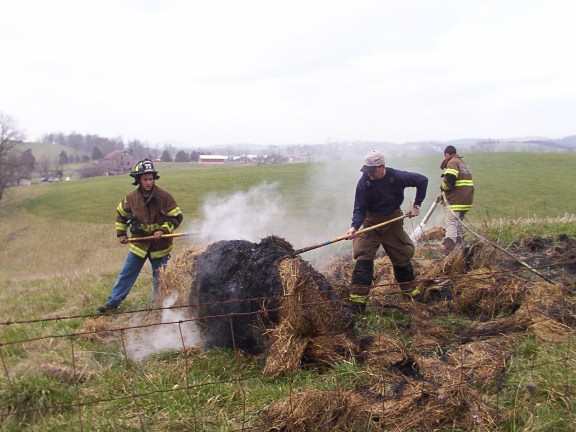
Agricultural News
Producers Should Be Aware of Potential for Hay Fires
Thu, 30 May 2013 12:53:21 CDT

Recent rainfall combined with rising ambient temperatures in the southern Great Plains should serve as a signal for agricultural producers to monitor their hay.
Although moderate temperature elevation is normal for baled hay put into storage, excess moisture in forage can result in hay heating to levels capable of spontaneous combustion.
"Whether hay actually burns depends primarily on stack size," said Ray Huhnke, director of the Oklahoma State University Division of Agricultural Sciences and Natural Resources' Biobased Products and Energy Center.
If heat developed in the pile can readily escape, the hay or straw may only mold or turn a tobacco-smell brown. However, if enough hay or straw is situated around the hot spot to prevent the escape of moisture and heat, the hot spot will burn.
Heating of wet hay or straw occurs in three stages: First, carbohydrates combine with oxygen to yield carbon dioxide, water and heat; temperatures may reach 130 degrees. Second, bacteria and fungi produce heat. This can raise temperatures to 170 degrees.
"In the third stage, oxygen combines with highly oxidizable material produced during second-stage heating," Huhnke said. "This process starts at about 170 degrees."
At this point, the situation becomes critical. Temperatures will continue to rise to the kindling point if enough oxygen and moisture are present to generate heat faster than it can escape.
"Monitor piles daily because sometimes it can take as much as a week before signs of a heating problem can arise," Huhnke said. "If the temperature reaches 140 degrees, recheck every few hours. If the temperature reaches 180 degrees, contact your local fire department. Do not move the hay until the fire department is present."
A steel rod can initially be used to check pile temperatures by driving it into the pile, waiting for 15 to 20 minutes and then pulling it out. If the rod is too hot to hold by hand, the situation is critical.
Huhnke cautions producers to stack hay in a locale where air can circulate around the pile to allow heat and moisture to escape. If possible, store large bales individually until the danger passes, then store in large stacks.
"Weeds can significantly increase the moisture content of otherwise dry material, so plan accordingly," he said. "As always, take time to monitor suspect piles and contact your local fire department if there is reason for concern."
Oklahoma is the eighth-largest hay-producing state in the nation, accounting for approximately $129 million in cash receipts annually.
By Donald Stotts, Communications Specialist, Oklahoma State University
WebReadyTM Powered by WireReady® NSI
Top Agricultural News
More Headlines...



















